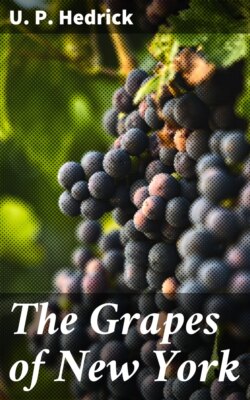Читать книгу The Grapes of New York - U. P. Hedrick - Страница 39
На сайте Литреса книга снята с продажи.
Оглавление1. Engelmann, Gray’s Man., Edition 5. 1867:679. V. aestivalis, var. CINEREA. 2. (?) Ib., Am. Nat., 2:321. 1868. V. aestivalis, var. CANESCENS. 3. Ib., Mo. Ent. Rpt., 1872:61. V. aestivalis, var. CINEREA. 4. Ib., Bush. Cat., 1883:10, 11, 12, 14, 16. Downy grape of Mississippi Valley. 5. Munson, Am. Hort. Soc. Rpt., 1885:133. 6. Ib., Am. Pom. Soc. Rpt., 1885:97, 98. Ashy-leaved grape; Sweet Winter grape. 7. Ib., Soc. Prom. Ag. Sci. Rpt., 1887:59. Ashy grape; Sweet Winter grape. 8. Planchon, De Candolle’s Mon. Phan., 5:323, 343. 1887. 9. Munson, U. S. D. A. Pom. Bul., 3:14. 1890. 10. Ib., Gar. and For., 3:474, 475. 1890. 11. Britton and Brown, 2:409. 1897. V. aestivalis, var. canescens; V. aestivalis, var. cinerea; Downy grape. 12. Bailey, Gray’s Syn. Fl., 1:425. 1897. Sweet Winter grape. 13. Beach, N. Y. Sta. An. Rpt., 17:536, 557. 1898. 14. Munson Tex. Sta. Bul., 56:218, 231, 240. 1900. Sweet Winter grape; Ashy grape. 15. Viala and Ravaz, Am. Vines, 1903:42, 80.
Vine vigorous, climbing; shoots more or less angled, covered with grayish pubescence which persists into winter; diaphragms thick to very thick; internodes medium to long; tendrils intermittent, long and strong, bifid. Leaves large, cordate, seldom lobed but frequently notched; frequently resembling a linden leaf; petiolar sinus medium in depth and width, rounded; margin shallowly but sharply toothed; upper surface cobwebby when young, becoming glabrous and dull when mature; lower surface and petiole covered with grayish cobwebby pubescence. Cluster large, rather loose; peduncle long; pedicel slender. Berries small, black, with little if any bloom. Seeds small, plump, short beak; chalaza round or oval, distinct; raphe ridge-like, distinct to slightly distinct. Ripening very late, becoming sweet after frost.
Cinerea is very closely allied to Aestivalis and was for a long time considered a part of that species. In 1867 Engelmann described it under the name Vitis aestivalis, var. cinerea, but in 1883 he made it a species and it has been generally regarded by botanists that the points of difference between the two forms are such that the Cinerea deserves specific recognition.
Its habitat is New York, west to Nebraska and Kansas with about 40 degrees as a northern limit, southward to the Gulf. Cinerea grows along streams mostly in limy soils, and is seldom found in very dry land. It covers about the same range as Cordifolia excepting that it grows nearer the Gulf and extends across the Rio Grande into Mexico.
The species is very late in blooming, later even than Cordifolia. It can be propagated from cuttings only with difficulty. It is probably of no importance horticulturally unless it be for wet lands.
